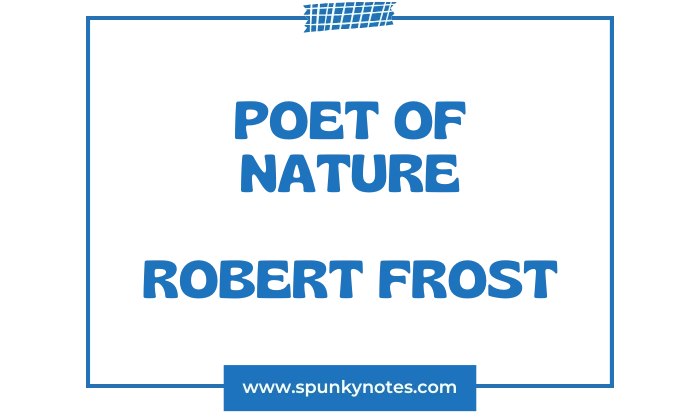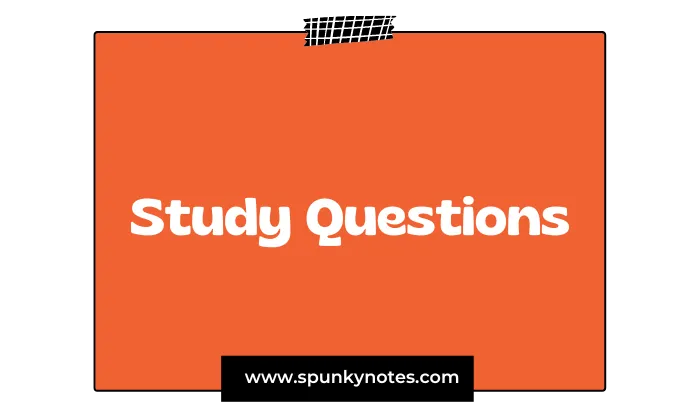
Q. Robert Frost is known as a nature poet because of his portrayal of rural landscapes. Discuss.
Robert Frost as a Poet of Nature
Robert Frost is known for his deep connection to nature, which he reflects in many of his poems. His portrayal of the natural world goes beyond scenic descriptions.
It highlights the interactions between humans and nature. Through his poetry, Frost shows how nature mirrors human emotions, decisions, and challenges.
1. Personal Connection to Nature
Frost’s connection to nature stems from his own life experiences. He spent much of his life in rural New England and became deeply familiar with the landscapes, seasons, and cycles of the natural world.
Frost is an American poet. Much of his work reflects his deep connection to the landscapes, seasons, and natural surroundings of New England, where he spent a significant part of his life.
Although he was born in California, Frost moved to New England at a young age. The region became central to his identity and poetic voice.
His poems often feature rural New England settings. They include descriptions of farms, forests, and rural life, all of which were key elements of his experience. These environments influenced his exploration of nature, rural life, and the human condition.
His experience as a farmer and his connection to rural communities gave him a practical understanding of nature. This personal relationship with the land is evident in his ability to present nature in a relatable and authentic manner.
2. Nature as a Symbol of Human Choices
In poems like “The Road Not Taken,” Frost uses nature to discuss life’s decisions. He uses the image of two diverging roads in a forest to represent the choices people face in life.
The speaker must decide which path to take. He knows this choice will shape his future. Frost uses this simple image from nature to reflect the universal experience of making decisions.
I shall be telling this with a sigh
Somewhere ages and ages hence:
Two roads diverged in a wood, and I—
I took the one less traveled by,
And that has made all the difference
Frost fills his poems with everyday images from nature—trees, woods, and seasons—yet each image carries deep meaning. His ability to make nature relatable to human life is what makes him a nature poet.
By using nature in his work, he invites readers to reflect on their own lives. He shows how the natural world can represent life’s challenges, decisions, and emotions.
3. Nature and Boundaries
In “Mending Wall,” Robert Frost uses nature to reflect on human relationships, especially the tension between tradition and change. The poem focuses on the annual task of repairing a stone wall that divides two neighboring properties.
One neighbor insists that “Good fences make good neighbors.” The other questions this belief, suggesting that the wall may not be necessary.
Nature, with its trees and animals, actively challenges the wall’s purpose. The speaker notes,
Something there is that doesn’t love a wall.
This hints that the forces of nature—whether trees pushing against the wall or the ground itself—are working against human efforts to maintain divisions.
In this way, nature acts as a force that questions human-made boundaries. The poem suggests that while people may feel the need to separate and control their space, nature tends to resist such divisions.
Frost uses nature to show how human desires for order and structure often conflict with the natural world’s inclination toward interconnectedness and unity.
4. Solitude and Reflection in Nature
In “Stopping by Woods on a Snowy Evening,” Robert Frost uses nature as a setting for solitude and reflection. The speaker pauses to watch the snow fall in a quiet, peaceful forest, surrounded by the beauty of the winter woods.
This moment of stillness allows for contemplation, as the speaker enjoys the calmness of nature. However, the poem also hints at a sense of isolation. The speaker is alone in the woods at night, far from civilization.
The lines “And miles to go before I sleep” suggest that, despite the comforting nature provides, there are responsibilities and obligations that cannot be ignored.
5. The Cycles of Nature
Frost connects the cycles of nature with human experiences. In “After Apple-Picking,” the speaker reflects on the labor of harvesting apples. This labor symbolizes the rewards and exhaustion of life’s work.
The changing seasons and the act of gathering apples mirror the passage of time and the physical toll of human effort. Nature shapes human lives, offering both challenges and fulfillment.
6. Nature as a Source of Escape
In “Birches,” Frost uses the image of bent birch trees to represent a desire for escape. The speaker imagines a boy swinging on the branches, leaving behind the struggles of adult life for a moment of freedom.
The birch trees symbolize the human longing to reconnect with innocence and simplicity. They provide a temporary reprieve from life’s burdens.
7. The Harsh Realities of Nature
Frost does not idealize nature. He also shows its unforgiving side. In “Out, Out—,” he describes a tragic accident involving a young boy using a buzz saw.
The poem highlights the indifferent nature of the world, where life and death occur without reason or fairness. Frost’s portrayal of nature includes its beauty, but also its harshness, reflecting the reality of human struggles within the natural world.
8. Nature as Both a Friend and a Force
Frost’s nature is neither wholly kind nor entirely hostile. It is a powerful force that influences human lives. It offers moments of peace, joy, and understanding, but also presents challenges and hardships.
Frost’s poems reveal a balanced view of nature, showing its dual role as a source of inspiration and a reminder of life’s fragility.
Robert Frost’s poetry reflects his deep understanding of nature as a vital part of human existence. Through images of forests, fields, and seasons, he connects nature to themes of choice, isolation, work, and escape.

